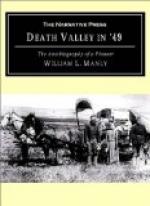This map was quite frequently exhibited and the matter freely discussed in camp, indeed speeches were made in the interest of the cut-off route which was to be so much shorter. A clergyman, the Rev. J.W. Brier, was very enthusiastic about this matter and discoursed learnedly and plausibly about it. The more the matter was talked about the more there were who were converted to the belief that the short road would be the best. The map showed every camp on the road and showed where there was water and grass, and as to obstacles to the wagons it was thought they could easily be overcome. A general meeting was called for better consideration of the question. Capt. Hunt said: “You all know I was hired to go by way of Los Angeles, but if you all wish to go and follow Smith I will go also. But if even one wagon decides to go the original route, I shall feel bound to go with that wagon.”
A great many were anxious to get the opinion of Capt. Hunt on the feasibility of the new route for he was a mountain man and could probably give us some good advice. He finally consented to talk of it, and said he really knew no more then the others about this particular route, but he very much doubted if a white man ever went over it, and that he did not consider it at all safe for those who had wives and children in their company to take the unknown road. Young men who had no family could possibly get through, and save time even if the road was not as good as Los Angeles road. But said he “If you decide to follow Smith I will go will go with you, even if the road leads to Hell.”
On the route from near Salt Lake to this point we found the country to grow more barren as we progressed. The grass was thinner, and sage brush took the place of timber. Our road took us in sight of Sevier Lake, and also, while going through the low hills, passed Little Salt Lake, which was almost dry, with a beach around it almost as white as snow. It might have had a little more the dignity of a lake in wet weather, but it was a rather dry affair as we saw it.




